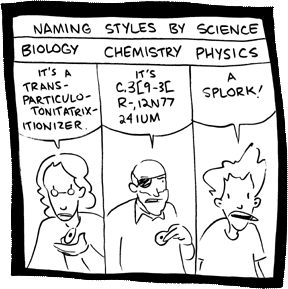Therefore, I think now is a good time to muse about those crazy physicists and their crazy naming conventions. Especially particle physicists. This SMBC comic is pretty accurate...

[Pro Tip: Hovering your mouse over that red circle on the SMBC website gives you extra funny]
Sadly, I must inform you that there is no such thing as a "splork" in particle physics... yet. However, I assure you that squarks are a serious possibility.
Let's break it down. These are all honest-to-goodness particle physics names!
Anyways, I think it's great that we have these names which are accessible and humorous. And perhaps the names give you a small window into how physicists view physics. We don't need some really arcane terminology, because the basic concepts which we describe are really not that arcane.
Let's break it down. These are all honest-to-goodness particle physics names!
- There are basically two types of particles: Fermions and Bosons. Fermions are "matter-building" particles, while Bosons are associated with forces.
- Bosons consist of photons, gravitons, gluons, and the W and Z bosons, which are associated with the electromagnetic, gravitational, strong, and weak forces respectively.
- The Fermions consist of Leptons, and Quarks.
- There are six flavors of leptons: electron, muon, tau and three associated neutrinos. Yes, "flavor" is a technical term.
- There are six flavors of quarks: up, down, charm, strange, top, and bottom
- I'm told that the top and bottom are sometimes called truth and beauty. Ironic, considering how elusive these particles are.
- Each quark has an associated quantum number. There's upness, downness, charmness, strangeness, and bottomness. Usually, no one cares about the top's quantum number, but I've concluded that it should be called "truthiness".
- The quarks always come in groups called hadrons. A quark-anti-quark pair is a meson, and a three-quark group is a baryon. Protons and neutrons are two kinds of baryons.
- Every fermion has an associated anti-particle. Not only do you have ups, downs, and electrons, but you also have anti-ups, anti-downs, and positrons, and so forth.
- You also got theoretical particles which have not yet been observed.
- The Higgs boson!
- Tachyons! They travel faster than light, and can go backwards in time.
- Super-symmetric particles! According to supersymmetry theory (abbreviated SUSY), every fermion should have a supersymmetric bosonic partner, and every boson should have a supersymmetric fermionic partner.
- The naming convention for supersymmetric partners of fermions is usually to add an "s" at the front of the name. So you got squarks and sleptons. Sleptons include the selectron, smuon, stau, and sneutrino. Squarks include sup, sdown, scharm, sstrange, stop, and sbottom.
- The naming convention for supersymmetric partners of bosons is usually to add an "ino" at the end, pronounced "ee-know". So we got photinos, gluinos, gravitinos, higgsinos, winos and zinos.
- Some mixture of photino, zino, and higgsino gives you the neutralino, which is the leading WIMP candidate for dark matter.
Anyways, I think it's great that we have these names which are accessible and humorous. And perhaps the names give you a small window into how physicists view physics. We don't need some really arcane terminology, because the basic concepts which we describe are really not that arcane.









3 comments:
There may not be such a thing as a splork in particle physics, but Google gave me 10,100 hits for splork on the Internet. Squark, on the other hand, gave me 1,220,000 hits and has its own Wikipedia and Encyclopedia Britannica entries as well as a Free Online Dictionary definition (and they don't exactly agree with each other).
Strange... several dictionaries seem to think that a squark is simply a strange quark. I can't find any scientific papers which use "squark" in this way.
Bosons have even integer multiples of the fundamental quantum spin unit wherein the fundamental unit is often labeled simply as 1/2. Fermions, on the other hand, have odd integer multiples of fundamental spin units of 1/2.
Post a Comment